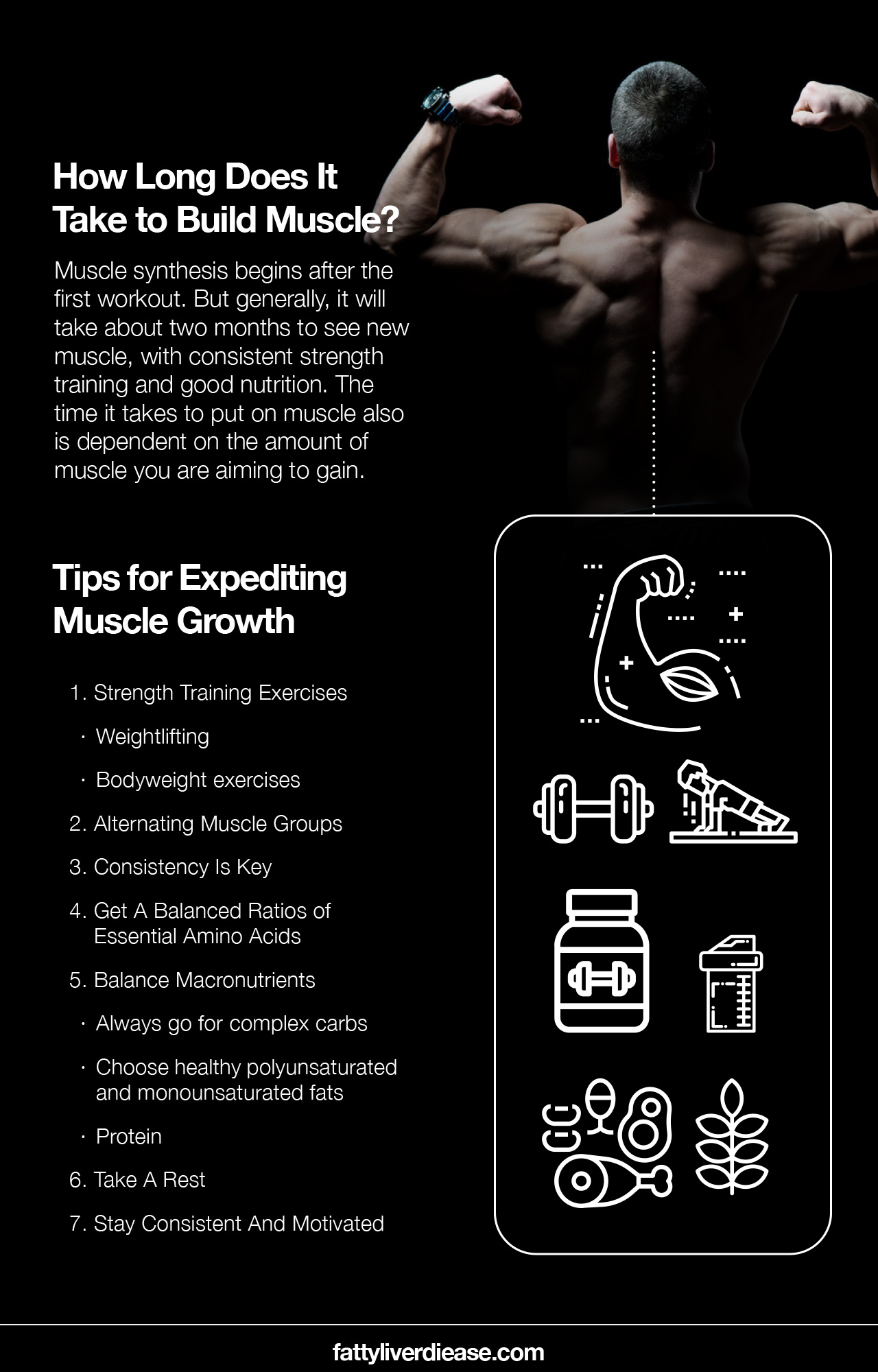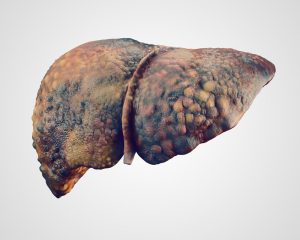Strength-training is becoming increasingly popular among adults of all ages and genders. However, building muscle doesn’t come easy. Instead, it takes diligent working out, carefully-planned nutrition, and a significant amount of time to build muscle. However, staying consistent and sticking to your training program and nutrition regimen will yield results.
So, exactly how long does it take to build muscle, and how can you support fast muscle growth? Read on to find out.
How Does Muscle Building Work?
Muscle synthesis requires both repeated use of the muscles combined with proper nutrition.
When you work out or engage in strength training, you are challenging your muscle tissue to engage in a particular activity. When you challenge your muscles, the small fibers that comprise your muscle tissues actually sustain small injuries and tear. During rest and with the aid of proper nutrition, these muscle fibers repair themselves and become larger and stronger.
Why Is Lean Muscle Mass Important, Anyways?
Why should we be focused on building muscle? Having lean body mass supports overall strength. When we hit our 30s, the body begins to gradually lose muscle mass through a process called sarcopenia. Muscle wasting is a natural process associated with aging. In fact, significant muscle loss is a significant contributing factor to aging-related conditions such as imbalance, weakness, and fatigue. However, counteracting the effects of aging by supporting the maintenance of lean muscle mass is associated with better health, longevity, and quality of life through older adulthood.
Lean muscle tissue also increases our basal metabolic rate, meaning that at rest, the body burns more calories. Having more muscle mass can help you achieve a healthy body weight while expediting the loss of body fat. Having a higher percentage of lean muscle tissue is also helpful for protecting against metabolic conditions and cardiovascular disease.
How Long Does It Take to Build Muscle?
So how fast can you gain muscle? One we start weight training, we all want to see those muscle gains immediately. The good news is that muscle synthesis begins after the first workout. But generally, it will take about two months to see new muscle, with consistent strength training and good nutrition. The time it takes to put on muscle also is dependent on the amount of muscle you are aiming to gain. For example, gaining 5 pounds of muscle may take a few months, while putting on 10 or more pounds of muscle may take 6 months or longer.
How much muscle can you gain in a month, with consistent training and nutrition? The rate of muscle growth varies for men and women. Men can expect to put on approximately 2 pounds of muscle in a month. How long does it take to build muscle for a woman? Women can expect to build approximately 1 pound of muscle per month. This variation in muscle growth rate is simply due to differences in hormones and body composition.
Age also plays a role in how quickly you can expect to build muscle. Individuals in their 20’s and 30’s will build muscle more quickly than older adults in their 50’s and 60’s.
Tips for Expediting Muscle Growth: How to Build Muscle Fast
Muscle growth is a science, and the body responds favorably to consistent exercise and good nutrition. Here we go through tips for the best way to build muscle.
1. Strength Training Exercises
Strength training is a form of exercise that challenges muscle fibers and causes them to strengthen and grow. Cardio, on the other hand, is a form of aerobic exercise that improves cardiovascular endurance. If you want to put on muscle, it’s imperative to engage in strength training exercises. Just be sure to engage in proper form, and if you have questions about how to execute a certain move, consult a personal trainer. Types of resistance training include:
- Weightlifting: Weightlifting not only for those interested in bodybuilding. Individuals of all fitness levels and at all places in their fitness journeys can engage in weightlifting. If you are new to weightlifting always start out with lighter weights. As you get stronger and get a custom to lifting weights, you can begin to lift heavier weights to encourage more muscle growth. You don’t even need to go to the gym in order to lift weights. You can have a small set of dumbbells at home that you can use to do all kinds of exercises, such as arm curls and weighted lunges. Deadlifts and benchpresses are examples of weight-lifting activities that are usually only done in a gym that has the proper equipment.
- Bodyweight exercises: Contrary to popular belief, you don’t need to lift weights in order to build muscle. Bodyweight exercises like pull-ups, push-ups, squats, lunges, and planks challenge different areas of your body and encourage muscle strengthening and growth.
2. Alternating Muscle Groups
When striving to gain lean muscle mass, you want to avoid working out the same muscle groups two days in a row. Alternating muscle groups allows your muscles a chance to rest and rebuild so that they’re ready for the next challenge.
For example, you can alternate upper body and lower body workouts. For example, one day you may focus on your arms, shoulders, and back muscles. The following day, you allow your upper body to rest and instead focus on challenging your leg muscles.
Alternatively, you can participate in full-body exercises that challenge all major muscle groups in one strength training workout. Just be sure to engage in these full-body workouts every other day, to allow for adequate rest and recuperation.
3. Consistency Is Key
If you work out every once in a while, you will not see any results in terms of muscle growth. Staying consistent is critical for yielding the muscle growth that you want. In fact, working out 30 minutes a day several times a week is far more effective than working out for several hours every other week. Frequency and consistency are the keys to getting the results that you want.
4. Getting Balanced Ratios of Essential Amino Acids
Protein intake is vital when you are aiming to build muscle. Why is protein intake so important? Getting enough protein is crucial because it offers amino acids, which are tiny nitrogenous compounds that the body uses for nearly all biological processes, like neurotransmitter synthesis and enzyme synthesis. In particular, getting optimal ratios of essential amino acids is vital for supporting protein synthesis, muscle synthesis, and repair post-workout.
The essential amino acids include histidine, leucine, isoleucine, valine, methionine, tryptophan, phenylalanine, lysine, and threonine. In order to sufficiently support muscle growth, the body requires an ideal amount of each of these amino acids. If one essential amino acid is obtained in less than ideal amounts, it will function as a limiting amino acid, which slows down muscle growth.
Many individuals engaging in strength training focus primarily on the amount of protein they’re eating. Though getting enough grams of protein is important in your dietary protein intake, getting optimal ratios of essential amino acids is even more important for muscle recovery. If you think you might not be getting an adequate balance of essential amino acids through the foods you eat, try incorporating a high-quality essential amino acid supplement into your regimen.
5. Balance Macronutrients
The key macronutrients in the human diet include protein, fat, and carbohydrates. Cutting out any one of these macronutrients is severely detrimental to the muscle-building process. Consuming all three of these macronutrients is essential for building muscle and reaching your fitness goals.
Carbohydrates are critical for supplying energy in the short term. Fueling up on carbohydrates is best before an intense workout, in order to supply the energy you need to give your best effort. Eating carbs increases your blood sugar, making glucose available for muscle cells. Muscle cells require sugar in order to function and power you through a workout. Healthy fat also supplies energy that releases more slowly while also supplying the raw materials to support cell membranes throughout the body. Protein, as described above, provides the building blocks that are directly used in muscle synthesis. Here are examples of dietary sources of each macronutrient that you should incorporate into your muscle-building diet:
- Carbohydrates: The key to healthy carbohydrate intake is by choosing your carbohydrates wisely. Not all carbohydrates are the same, and they can be categorized into simple carbohydrates and complex carbohydrates. Always go for complex carbs, which don’t spike your blood sugar. Excellent examples of complex carbs to fill your workouts include whole-grain bread, whole-grain pasta, quinoa, millet, oats, bananas, and sweet potatoes.
- Fats: As is the case with carbohydrates, there are both good fats and bad fats. Always steer clear of saturated fat and transfers, which contribute to the risk of developing anabolic diseases and heart disease. Instead, choose healthy polyunsaturated and monounsaturated fats. Excellent sources of healthy fats include avocado, pecans, walnuts, almonds, pumpkin seeds, flaxseeds, chia seeds, salmon, and sardines.
- Protein: As discussed above, proteins provide optimal ratios of essential amino acids. Low-fat animal products or a variety of plant-based proteins can help you reach optimal ratios of essential amino acids, although supplementation can be very helpful as well.
You also want to make sure that your calorie intake is sufficient for fueling your workouts and facilitating repair. How many calories should you eat to gain muscle? The number of calories required to build muscle varies for each individual. However, keep in mind that building muscle requires you to consume an excess of calories. For this reason, many bodybuilders and lifters use the “bulk and cut” method to build muscle. Bulking entails consuming a surplus of energy to facilitate muscle growth, while cutting requires reducing your calorie intake to lose excess fat.
The bottom line is that skimping on macronutrients or calories won’t get you the results you want. Make sure you get an ideal ratio of macronutrients and energy to fuel fast muscle growth.
6. Rest Days
Your body can’t successfully build muscle without an adequate amount of recuperation. Your muscle tissue relies on rest time so that the body can configure essential amino acids and synthesize protein. Set a goal to work out at least 3 times per week to keep the muscle growth on an upward trajectory. Working out 3 times per week also allows for ample time for rest. If you are adhering to a more intense workout regimen, aim to have one full rest day each week.
7. Patience
When you are striving to build muscle, you won’t see results overnight. Many factors influence how quickly you’ll see results, including initial fitness level and genetic potential. It also depends on the muscle size you are striving to achieve. However, staying consistent and patient will help you stay motivated to workout and engage in strength training. With a little patience, you will start seeing results!
Conclusion: How Long Does It Take to Build Muscle?
So, how long does it take to build muscle? When you first start a workout regimen, you can expect to start building muscle right away. However, visible muscle definition won’t be apparent for a couple of months. Both exercise and the foods you eat are vital components of a muscle-building plan. Exercise must include regular strength training several times a week. Nutrition must encompass a balance of fat, carbohydrates, and protein for optimal ratios of essential amino acids. If you stick to your training routine, nutrition plan, and frequency, you will build lean muscle tissue that can improve your weight, quality of life, and longevity.
























